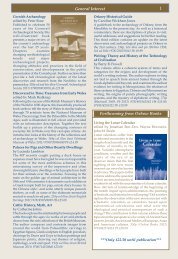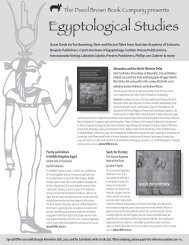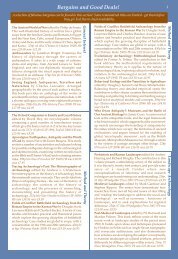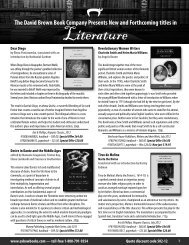New Distributed Titles Fall 2009 - Oxbow Books
New Distributed Titles Fall 2009 - Oxbow Books
New Distributed Titles Fall 2009 - Oxbow Books
You also want an ePaper? Increase the reach of your titles
YUMPU automatically turns print PDFs into web optimized ePapers that Google loves.
Language � Linguistics<br />
Conflicts in Interpretation<br />
by Petra Hendriks, Helen de Hoop,<br />
Irene Krämer, Henriëtte de Swart and Joost Zwarts<br />
This volume applies novel methods of constraint interaction, derived<br />
from connectionist theories and implemented in linguistics within<br />
the framework of Optimality Theory, to core semantic and pragmatic<br />
issues such as polysemy, negation, (in)definiteness, focus, anaphora,<br />
and rhetorical structure. It explores the hypothesis that a natural language<br />
grammar is a set of potentially conflicting constraints on forms<br />
and meanings and hypothesizes that competent language users not<br />
only optimize from an input form to the optimal output meaning for<br />
this form, or vice versa, but also consider the opposite direction of optimization,<br />
thus taking into account the speaker as a hearer and taking<br />
into account the hearer as a speaker.<br />
192p, 21 b/w figs, Equinox Publishing, December <strong>2009</strong>,<br />
Advances in Optimality Theory.<br />
paperback, 9781845534387, $37.95; hardback, 9781845534370, $95.00(s)<br />
The Semantics of English Negative Prefixes<br />
by Zeki Hamawand<br />
This volume proposes a new system for describing the semantic properties<br />
of negative prefixes in English. Specifically, the system captures<br />
the semantic distinctions between pairs of negative words that share<br />
same bases but end in different prefixes like amoral vs. immoral, etc.<br />
The book provides guidance as a reference for derivation, informing<br />
the reader about the mechanisms of forming negative words, and as<br />
a reference for usage, it explores the meaning differences between<br />
prefixally-negated words. To do so, it bases the description on actual<br />
instances and supports the differences by means of collocations.<br />
192p, 27 figs, hardback, 9781845535407, $95.00, Equinox Publishing,<br />
September <strong>2009</strong>.<br />
4<br />
Functional Dimensions of Ape-Human Discourse<br />
edited by James D Benson and William S Greaves<br />
This volume asks the question, ‘What do interactions between apes and humans<br />
mediated by language tell us?.’ In order to answer this question, the authors explore<br />
language-in-context, drawing on multi-leveled, multi-functional linguistics. The levels<br />
are context of culture, context of situation, semantics, lexicogrammar, and phonology;<br />
the functions are ideational, interpersonal, and textual. Chapters discuss negotiation<br />
between the bonobo Kanzi and Sue Savage-Rumbaugh in terms of discourse-semantics,<br />
lexicogrammar, and the metafunctions of language, provide corroborative evidence for<br />
Kanzi’s symbolic processing abilities, and compare three snapshots from comprehensive<br />
studies based on large amounts of data from an evolutionary perspective.<br />
192p, 24 b/w illus, 11 b/w photos, paperback, 9781845536534, $50.00,<br />
Equinox Publishing, September <strong>2009</strong>, Functional Linguistics.<br />
Also available in hardback (2005), 9781904768050, $95.00(s)<br />
Statistical Methods in Language<br />
and Linguistic Research<br />
by Pascual Cantos Gómez<br />
The aim of this volume is to try to illustrate with numerous<br />
examples how quantitative methods can most fruitfully<br />
contribute to linguistic analysis and research. It presents<br />
some mathematical and statistical properties of natural<br />
languages, and introduces some of the quantitative<br />
methods which are of the most value in working empirically<br />
with texts and corpora, illustrating the various issues<br />
with numerous examples and moving from the most basic<br />
descriptive techniques to decision-taking techniques<br />
and to more sophisticated multivariate statistical language models.<br />
256p, 77 figs, Equinox Publishing, December <strong>2009</strong>.<br />
paperback, 9781845534325, $29.95; hardback, 9781845534318, $95.00(s)<br />
Aspects of Cognitive Ethnolinguistics<br />
by Jerzy Bartmiński, edited by Jörg Zinken<br />
This volume provides an introduction to a highly-developed,<br />
coherent, and extensively-tested cognitive linguistic<br />
approach to lexical semantics, which is not currently<br />
accessible to readers of English. It also shows that the<br />
main tenets of this approach are not an incidental historical<br />
development in a particular corner of the world, but<br />
rather are arrived at by scholars working in hugely different<br />
contexts independently of each other.<br />
256p, 2 figs, hardback, 9781845533427, $120.00, Equinox<br />
Publishing, September <strong>2009</strong>, Advances in Cognitive Linguistics.<br />
<strong>New</strong> in paperback!<br />
The David Brown Book Company – <strong>Fall</strong> <strong>2009</strong>

















